#US National Institutes for Health Research Report
Note
if you want to answer (and i totally understand if you dont), who do you think bombed the hospital in gaza? ive seen a lot of different people talking about it and blaming different people & organizations and you seem like you know a lot aboit i/p
IMPORTANT TO NOTE: i am not a news source. i am some guy with access to the internet. please follow the links in this post, as well as doing your own research. please do not use social media posts exclusively as your source of news, and please continuously read and compare several different accredited news sources. keep on top of new sources and evidence that are being put out to ensure that you have the most up-to-date information.
it's not really about who i think did it. i feel like that centers me in a thing that is very much not about me. but i'll give it my best shot.
we still do not have confirmation of how many were killed or who is at fault for the bombing. there are a lot of numbers and opinions floating around online, but as of 4pm on october 19th there has not been a consensus on either of these things from any accredited organizations.
that being said, here are the statements that have been put out as of the time i'm responding to this:
statements about death toll:
the gaza health ministry estimates between 200 and 471 dead
the director of al-shifa hospital where people were brought from al-ahli estimates 250 dead
an assessment from the us director of national intelligence estimates between 100 and 300
an analyst with the center for naval analysis, after viewing photos and video, said the death toll was closer to 50
statements about fault:
(taking these directly from the article)
J Andres Gannon, an assistant professor at Vanderbilt University, in the US, says the ground explosions appeared to be small, meaning that the heat generated from the impact may have been caused by leftover rocket fuel rather than an explosion from a warhead.
Justin Bronk, senior research fellow at the UK-based Royal United Services Institute, agrees. While it is difficult to be sure at such an early stage, he says, the evidence looks like the explosion was caused by a failed rocket section hitting the car park and causing a fuel and propellant fire.
Mr Gannon says it is not possible to determine whether the projectile struck its intended target from the footage he has seen. He adds that the flashes in the sky likely indicate the projectile was a rocket with an engine that overheated and stopped working.
Valeria Scuto, lead Middle East analyst at Sibylline, a risk assessment company, notes that Israel has the capacity to carry out other forms of air strike by drone, where they might use Hellfire missiles. These missiles generate a significant amount of heat but would not necessarily leave a large crater. But she says uncorroborated footage shows a pattern of fires at the hospital site that was not consistent with this explanation.
Visual evidence from the blast site
The BBC was able to match details of buildings and the layout of the Al-Ahli hospital site with publicly available satellite imagery, to establish the hospital was the scene of the blast.
Based on available evidence, it appears the explosion happened in a courtyard which is part of the hospital site. Images of the ground after the blast do not show significant damage to surrounding hospital buildings. What the images do show are scorch marks and burnt-out cars.
where the explosive came from
so far, israel, hamas, and palestinian islamic jihad have all denied responsibility
channel 4 news reported that palestinian islamic jihad had uncovered a warhead but they have not produced it
in a since-deleted tweet, hananya naftali, a social media advisor for netanyahu, claimed that it was an israeli airstrike that hit the hospital. he followed up by stating that he had shared incorrect information based on a reuters headline that refered to an israeli airstrike
tentative conclusion based on sources:
what i gather from what i've read is that the blast was likely caused by a misfired rocket originating somewhere in gaza, and the blast was exacerbated by the fuel in the rocket. BUT, as i stated before, new information is always being put out. there could be evidence released tomorrow that it was an israeli air strike. there has been no conclusive evidence yet.
and perhaps the most important section:
what you can actually do to help
if you are in the us, call your representatives and urge them to support the resolution for a ceasefire
check out this list of verified aid groups (if there is not a ceasefire as soon as possible, it won't matter what aid is sent to them and if they cannot get the supplies into gaza, so refer back to the first bulletpoint)
send a donation to your local synagogue(s) and mosque(s) to help them offset the rising costs of security
take a moment to be a human. don't think about the numbers. don't think about the politics. think about the human beings who lost their lives, and the people who are mourning them. the mothers who will never see their children again, the children who will grow up without parents. what did they have for breakfast? what was their favorite song? when was their birthday? were they afraid? were they in pain? what can we do to ensure this does not happen again?
134 notes
·
View notes
Text
The Best News of Last Week - January 09, 2023
1. Top British universities offer Afghan women free courses until Taliban lift learning ban

Afghanistan's ruling Taliban announced last month that women would no longer be able to study at universities and higher education establishments. Institutions were told to implement the ban as soon as possible.
Now, a number of British universities have teamed up through FutureLearn to offer the women in Afghanistan free access to digital learning platforms. Girls and women with internet access will be able to study more than 1,200 courses from top institutions at no cost to themselves.
2. Arizona Gov. Katie Hobbs extends protections to LGBTQ+ state employees and contractors

Arizona’s newly elected Gov. Katie Hobbs (D) signed an executive order extending employment protections to state employees and contractors who are LGBTQ+.
As the Human Rights Campaign reports, the executive order, signed on Hobbs’s first day in office Tuesday, directs the state’s Department of Administration to update hiring, promotion, and compensation policies for all state agencies to prohibit discrimination based on sexual orientation and gender identity and include provisions in all new state contracts to prohibit discrimination based on sexual orientation and gender identity.
3. EU Carbon Emissions Drop To 30-Year Lows

It was supposed to be a dirty autumn and winter, with European nations scrambling to replace Russian gas with high-polluting coal. But according to the Centre for Research on Energy and Clean Air, the cold seasons so far have been the cleanest in more than 30 years.
4. Critically endangered rhinoceros gives birth to calf at Kansas City Zoo on New Year's Eve

The Kansas City Zoo got a special start to the new year: A critically endangered subspecies of rhinoceros gave birth to a calf on Dec. 31, officials announced. The calf is walking, nursing and even playing with its mother, Zuri, animal specialists said.
5. Cancer Vaccine to Simultaneously Kill and Prevent Brain Cancer Developed

Scientists are harnessing a new way to turn cancer cells into potent, anti-cancer agents. A new stem cell therapy approach eliminates established brain tumors and provides long-term immunity, training the immune system to prevent cancer from returning.
link to the paper …
6. The US has approved use of the world's first vaccine for honey bees.

It was engineered to prevent fatalities from American foulbrood disease, a bacterial condition known to weaken colonies by attacking bee larvae. As pollinators, bees play a critical role in many aspects of the ecosystem.
The vaccine could serve as a "breakthrough in protecting honey bees", Dalan Animal Health CEO Annette Kleiser said in a statement. It works by introducing an inactive version of the bacteria into the royal jelly fed to the queen, whose larvae then gain immunity.
7. Cat missing for nearly 6 years reunited with owner thanks to microchip

West Sacramento woman got the surprise of a lifetime Saturday when she was reunited with her missing cat after nearly 6 years thanks to microchip.
- - -
That's it for this week. If you liked this post you can support this newsletter with a small kofi donation:
Buy me a coffee ❤️
Subscribe for more weekly wholesome news...
477 notes
·
View notes
Text
So I was scrolling and saw this image in an article about the European heat wave,
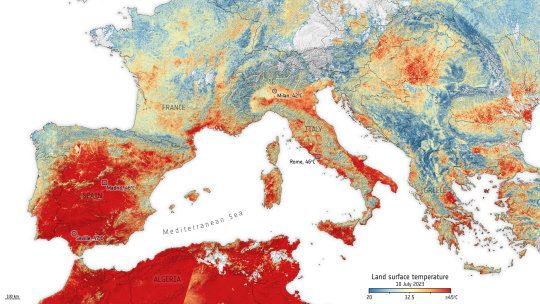
And was like, uh, are you missing something there, buddy? Like all that red in northern Africa? Because that's a lot of red.
And I was going to give them the benefit of doubt, since I don't know much about the climate in Northern Africa, aside from Morroco and Egypt, which seem like really hot places, so you know, maybe it's normal there?
But nope, that's not the case:
"While the planet broke multiple records for average worldwide temperatures last week, a heat wave gripped northern Africa.
The region has been experiencing some of the most intense heat waves in recent years, but in many cases they’ve been under-reported due to misconceptions about Africans’ ability to withstand them.
“Africa is seen as a sunny and hot continent,” said Amadou Thierno Gaye, a research scientist and professor at Cheikh Anta Diop University in Dakar, the capital of Senegal. “People think we are used to heat, but we are having high temperatures for a longer duration. Nobody is used to this.”
North Africa, the Sahara desert and the Sahel, a semi-arid belt north of the Sudanian savanna, are some of the most vulnerable areas because they have larger land masses relative to the rest of the continent, meaning they tend to heat up faster. Scientists have attributed the unprecedented temperatures to a combination of human-induced climate change and the return of El Niño, a natural phenomenon that alters weather patterns.
The Sahel, for instance, has been heating at a faster pace than the global average despite being hot already. Burkina Faso and Mali, both in West Africa’s Sahel, are among countries that are set to become almost uninhabitable by 2080, if the world continues on its current trajectory, a UK university study found. Its people are especially vulnerable due to shrinking resources, such as water, and poor amenities, and a dearth of trees and parks means there are few options for places to cool off.
“People talk of climate change as if it’s a thing of the future,” said Gaye. “Climate change is already here and we see its implications in people, livelihoods, economies and even in cultures.”
While studies on heat impacts on health are limited in Africa, research published last year found that children younger than 5 years old are particularly vulnerable to the hotter weather as they are less able that adults to self-regulate their bodies’ temperatures. The authors estimated that heat-related child mortality was rising in sub-Saharan Africa due to climate change. Other researchers have named the elderly, pregnant women and people who work outdoors, as groups at risk of heat strokes or heat-related infectious diseases.
Elsewhere on the continent, the crisis is also being felt. In the Horn of Africa, at least 43,000 people died in Somalia alone last year as a result of the worst drought in four decades. A study found that global warming is changing rain patterns and bringing more heat to Somalia and some of its neighbors, for longer stretches of time. Further south, unusually destructive cyclones in 2019 claimed more than a thousand lives in Mozambique and Zimbabwe alone.
“If we continue business-as-usual, the heat is not just going to get worse, it will get much worse,” said Mouhamadou Bamba Sylla, research chair in climate change science at the African Institute for Mathematical Sciences in Kigali, the capital of Rwanda. “We are going to see more frequent, longer and more intense heat waves.”
Much of the continent, responsible for just 4% of the world’s greenhouse gas emissions generated from burning fossil fuels, is ill-prepared for a hotter world. Meanwhile, Group of 20 nations, with air conditioning and access to functioning healthcare facilities, account for 80% of the world’s emissions.
Hundreds of millions of Africans lack electricity to even power a fan. One in three people in Africa is affected by water scarcity, according to the World Health Organization, so hydration can’t be taken for granted. Even shade is harder to come by due to widespread deforestation and land degradation. And only 40% of people on the continent are covered by early warning systems for extreme weather.
“More funds have to be allocated to climate adaptation and they need to be made more easily accessible to the most vulnerable countries,” Sylla said.
The UN climate talks later this year aspire to come up with a plan for richer nations to pay for loss and damages. But they’ve collectively fallen short of their commitment to spend $100 billion each year on projects in developing nations to cut emissions and to help them adapt.
“That’s where the issue of climate justice comes in,” said Gaye. “It’s not just that people are uncomfortable, climate change is killing them.”
#climate change#is happening now#we're seeing the effects now#reminder that western countries stole people and resources from Africa#environmental racism
252 notes
·
View notes
Text
Detransitioner news
I have been thinking about detransitioners lately and wanted to compile articles I have been seeing. This will be a longer post and reblogged for part II as I hope to copy and paste brief portions of the articles under each headline.
Law firm for detransitioners opens in Dallas

In all of the controversy around gender transition, there is one group that is persistently marginalized by both the right and left.
They are known as detransitioners — people who decide that they want to return to their birth gender, often after receiving years of interventional care, including surgery, to treat their gender dysphoria.
Now, the nation’s first law firm focused solely on representing these patients — many of whom feel abused by a medical system that encouraged their treatment — has opened its doors in Dallas.
It could forever change how hospitals and doctors approach what’s known as gender-affirming care.
Archive link
Fenway Community Health Center in Boston, the largest provider of transgender medicine in New England and one of the leading institutions of its kind in the United States, was named a defendant in a lawsuit filed last month. The plaintiff, a gay man who goes by the alias Shape Shifter, argues that by approving him for hormones and surgeries, Fenway Health subjected him to “gay conversion” practices, in violation of his civil rights. Carlan v. Fenway Community Health Center is the first lawsuit in the United States to argue that “gender-affirming care” can be a form of anti-gay discrimination.
The case underscores an important clinical reality: gender dysphoria has multiple developmental pathways, and many who experience it will turn out to be gay. Even the Endocrine Society concedes that many of the youth who outgrow their dysphoria by adolescence later identify as gay or bisexual. Decades of research confirm as much. Gender clinicians in the U.K. used to have a “dark joke . . . that there would be no gay people left at the rate [the Gender Identity Development Service] was going,” former BBC journalist Hannah Barnes reported. Rather than help young gay people to accept their bodies and their sexuality, what if “gender-affirming” clinicians are putting them on a pathway to irreversible harm?
Due partly to Shape’s lifelong difficulty in accepting himself as gay, his lawyers are not taking the usual approach to detransition litigation. Rather than state a straightforward claim of medical malpractice or fraud, they allege that Fenway Health has violated Section 1557 of the Affordable Care Act (ACA), which bans discrimination “on the basis of sex” in health care. In 2020, the Supreme Court ruled in Bostock v. Clayton County that “discrimination because of . . . sex” includes discrimination based on homosexuality. Citing this and other precedents, Shape’s lawyers argue that federal law affords distinct protections to gay men and lesbians—upon which clinics that operate with a transgender bias are trampling.
Shape grew up in a Muslim country in Eastern Europe that he describes in an interview as “very traditional” and “homophobic.” His parents disapproved of his effeminate demeanor and interests as a child. They wouldn’t let him play with dolls, and his mother, he says, made him do stretches so that he would grow taller and appear more masculine.
At 11, Shape had his first of several sexual encounters with older men. “I was definitely groomed,” he recounts. Shape proceeded to develop a pattern of risky sexual behavior, according to his legal complaint. He told his medical team at Fenway Health about his childhood sexual experiences, calling them “consensual.” The Fenway providers never challenged him on this interpretation, he alleges. They never suggested that he might have experienced sexual trauma or, say, explored how these events might have shaped his feelings of dissociation. (The irony is that Fenway Health describes its model of care as “trauma-informed.”)
Archive link
Ontario detransitioner who had breasts and womb removed sues doctors

An Ontario detransitioning woman who had her breasts and womb removed to change her gender to male is suing medical and health practitioners for failing to consider other treatments during her mental health crisis before ushering her on an irreversible journey she regrets.
Michelle Zacchigna, 34, of Orillia, Ont., north of Toronto, names eight health professionals, including doctors, psychologists, a psychotherapist and a counsellor in a lawsuit filed in Ottawa.
None of the defendants, who work or worked at various clinics and institutions in southern Ontario, responded to requests for comment on the lawsuit prior to deadline. Four of the defendants have filed notices of intent to defend against the suit in Ontario Superior Court, but no statements of defense have been filed. None of the claims have been tested in court.
Zacchigna said she faces an uphill battle in her lawsuit.
“I’ve been under the impression that all medical malpractice suits are challenging. Doctors win the majority of cases in Canada,” she told National Post.
“It’s very much a David vs. Goliath undertaking.”
In her statement of claim filed in court in November, Zacchigna says she had difficulty forming relationships with classmates in elementary school and was often bullied.
By the time she was 11, she engaged in self-harming behaviour, including cutting her arm with a knife. This continued into early adulthood.
When she was 20, she tried to kill herself and she was referred by her family doctor for psychotherapy, where she was treated for social anxiety and clinical depression.
She remained unhappy and depressed, and her mental health decline led to her dropping out of university, according to her claim.
About a year into therapy, she engaged with an online community around gender nonconformity.
“Michelle came to believe that her biological sex of female did not match her true gender identity of male,” her claim says.
“She further came to believe that this mismatch between her biological sex and gender identity was causing her feelings of depression, self-harming behaviour and unease in her body, a mental health condition commonly known as gender dysphoria,” her claim states.
This was the first time Zacchigna felt she was born in the wrong body, and she had not previously identified as male, her claim says.
“However, as a result of what she read on the internet, she became convinced that she was a transgender man, and that once she embraced this new identity, her depression would subside.”
Zacchigna started attending a support group in Toronto for people considering gender transition. A counsellor there told her of opportunities to proceed through a medical transition, her claim says.
Zacchigna was invited to apply for medical intervention in 2010.
The counsellor wrote a recommendation letter outlining a medical history that didn’t fully match her real past, the claim says. The counsellor didn’t recommend any alternatives, or seek confirmation of Zacchigna’s own diagnosis of gender dysphoria.
Her regular therapist also wrote a recommendation for transition treatment, saying Zacchigna was an “ideal candidate for hormone therapy,” even though the therapist had no previous transgender clients, according to the claim.
Part II incoming.
#detrans#detransition#desist#ftm detransition#mtf detransition#LGB#gender critical#gender critical feminism#gender ideology
75 notes
·
View notes
Text
The phone or computer you’re reading this on may not be long for this world. Maybe you’ll drop it in water, or your dog will make a chew toy of it, or it’ll reach obsolescence. If you can’t repair it and have to discard it, the device will become e-waste, joining an alarmingly large mountain of defunct TVs, refrigerators, washing machines, cameras, routers, electric toothbrushes, headphones. This is “electrical and electronic equipment,” aka EEE—anything with a plug or battery. It’s increasingly out of control.
As economies develop and the consumerist lifestyle spreads around the world, e-waste has turned into a full-blown environmental crisis. People living in high-income countries own, on average, 109 EEE devices per capita, while those in low-income nations have just four. A new UN report finds that in 2022, humanity churned out 137 billion pounds of e-waste—more than 17 pounds for every person on Earth—and recycled less than a quarter of it.
That also represents about $62 billion worth of recoverable materials, like iron, copper, and gold, hitting e-waste landfills each year. At this pace, e-waste will grow by 33 percent by 2030, while the recycling rate could decline to 20 percent. (You can see this growth in the graph below: purple is EEE on the market, black is e-waste, and green is what gets recycled.)
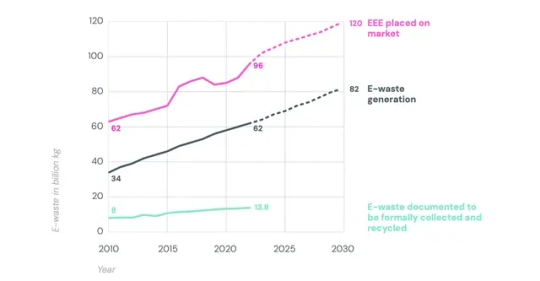
“What was really alarming to me is that the speed at which this is growing is much quicker than the speed that e-waste is properly collected and recycled,” says Kees Baldé, a senior scientific specialist at the United Nations Institute for Training and Research and lead author of the report. “We just consume way too much, and we dispose of things way too quickly. We buy things we may not even need, because it's just very cheap. And also these products are not designed to be repaired.”
Humanity has to quickly bump up those recycling rates, the report stresses. In the first pie chart below, you can see the significant amount of metals we could be saving, mostly iron (chemical symbol Fe, in light gray), along with aluminum (Al, in dark gray), copper (Cu), and nickel (Ni). Other EEE metals include zinc, tin, and antimony. Overall, the report found that in 2022, generated e-waste contained 68 billion pounds of metal.
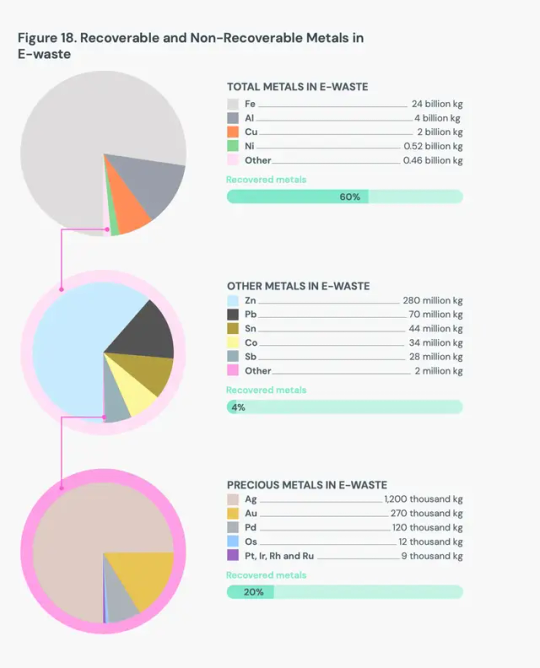
E-waste is a complex thing to break down: A washing machine is made of totally different components than a TV. And even for product categories, not only do different brands use different manufacturing processes, but even different models within those brands vary significantly. A new washing machine has way more sensors and other electronics than one built 30 years ago.
Complicating matters even further, e-waste can contain hazardous materials, like cobalt, flame retardants, and lead. The report found that each year, improperly processed e-waste releases more than 125,000 pounds of mercury alone, imperiling the health of humans and other animals. “Electronic waste is an extremely complex waste stream,” says Vanessa Gray, head of the Environment and Emergency Telecommunications Division at the UN’s International Telecommunication Union and an author of the report. “You have a lot of value in electronic waste, but you also have a lot of toxic materials that are dangerous to the environment.”
That makes recycling e-waste a dangerous occupation. In low- and middle-income countries, informal e-waste recyclers might go door-to-door collecting the stuff. To extract valuable metals, they melt down components without proper safety equipment, poisoning themselves and the environment. The new report notes that in total, 7.3 billion pounds of e-waste is shipped uncontrolled globally, meaning its ultimate management is unknown and likely not done in an environmentally friendly way. Of that, high-income countries shipped 1.8 billion pounds to low- and middle-income countries in 2022, swamping them with dangerous materials.
High-income countries have some of this informal recycling, but they also have formal facilities where e-waste is sorted and safely broken down. Europe, for example, has fairly high formal e-waste recycling rates, at about 43 percent. But globally, recycling is happening nowhere near enough to keep up with the year-over-year growth of the waste. Instead of properly mining EEE for metals, humanity keeps mining more ore out of the ground.
Still, the report found that even the small amount of e-waste that currently gets recycled avoided the mining of 2 trillion pounds of ore for virgin metal in 2022. (It takes a lot of ore to produce a little bit of metal.) The more metals we can recycle from e-waste, the less mining we’ll need to support the proliferation of gadgets. That would in turn avoid the greenhouse gases from such mining operations, plus losses of biodiversity.

The complexity of e-waste, though, makes it expensive to process. As the chart above shows, even an ambitious scenario of a formal e-waste collection rate in 2030 is 44 percent. “There is no business case for companies to just collect e-waste and to make a profit out of this in a sustainable manner,” says Baldé. “They can only survive if there is legislation in place which is also compensating them.”
The report notes that 81 countries have e-waste policies on the books, and of those, 67 have provisions regarding extended producer responsibility, or EPR. This involves fees paid by manufacturers of EEE that would go toward e-waste management.
Of course, people could also stop throwing so many devices away in the first place, something right-to-repair advocates have spent years fighting for. Batteries, for instance, lose capacity after a certain number of charge cycles. If a phone can’t hold a charge all day anymore, customers should be able to swap in a new battery. “Manufacturers shouldn't be able to put artificial limitations on that ability,” says Elizabeth Chamberlain, director of sustainability at iFixit, which provides repair guides and tools. That includes limiting access to parts and documentation. “Repair is a harm-reduction strategy. It's not the be-all-end-all solution, but it's one of many things we need to do as a global society to slow down the rate at which we're demanding things of the planet.”
At the core of the e-waste crisis is the demand: A growing human population needs phones to communicate and fridges to keep food safe and heat pumps to stay comfortable indoors. So first and foremost we need high-quality products that don’t immediately break down, but also the right to repair when they do. And what absolutely can’t be fixed needs to move through a safe, robust e-waste recycling system. “We are consuming so much,” says Baldé, “we cannot really recycle our way out of the problem.”
26 notes
·
View notes
Text
In the early 1990s—at the peak of a 20-year growth in the US crime rate—the federal government announced the launch of a "violence initiative." Headed by the US Public Health Service and backed by senior psychiatrists such as Fredrick Goodwin (then chief scientist at the National Institute of Mental Health (NIMH)), this project drew on biological theories of crime which dated back to the nineteenth century Lombrosian concept of the "born criminal". It was proposed that a mass-screening programme of inner-city children would be undertaken across America to determine those biologically or genetically predisposed towards anti-social and violent behaviour. As a vaccine against criminality, once the "conduct-disordered" children had been identified they could then be administrated psychotropic drugs. Breggin and Breggin's detailed discussion of the violence initiative rightly demonstrates the racist ideology behind the supposed objectivity of this biomedical project; a focus on inner-city youth is blatantly a focus on minority and black communities. At the time, Goodwin allegedly made remarks at the National Advisory Mental Health Council comparing "inner-city youth to monkeys who live in a jungle, and who just want to kill each other, have sex, and reproduce".
Psychiatry's involvement in such projects is perhaps less shocking when considering their long support for racial theories of the mind. In 1850, physician Samuel Cartwright reported in The New Orleans Medical and Surgical Journal his discovery of two new mental disorders affecting slaves in the Deep South: the first, drapetomania, was a disease causing slaves to run away from their owners, while the second, dysaesthesia aethiopis, resulted in the slaves becoming lazy, showing a lack of respect for the rights of property and breaking work tools. The prescribed cure for both disorders was "whipping, hard labor, and, in extreme cases, amputation of the toes". This psychiatric naturalisation of slavery as normal, inevitable, and even healthy for the black slave has been referred to by Burstow as a blatant example of "social control medicalized." Yet as Greenberg reminds us, for the burgeoning community of mad doctors, the discovery of such mental conditions held out the promise of contributing to contemporary society through the establishment of new "scientific" ideas in the area.
The commonalities between slavery-era diagnostic constructions and psychiatry's recent focus on inner-city youth are what Breggin and Breggin describe as "the psychiatric labeling of resistive or rebellious activity in order to justify medical control." This process of enforcing the status quo through the biomedical pathologisation of the political has allowed the psychiatric profession to enhance their respectability, capital, and power in capitalist society. Though treated with suspicion by some colleagues in the north of the United States, Cartwright's ideas were widely supported by fellow physicians, local politicians, and slave owners in the south. Whereas the classifications were abruptly consigned to history by the civil war only a few years later, drapetomania, along with Kraepelin's biological theories on praecox (later relabelled as schizophrenia), were highly influential on medical researchers in the early twentieth century who contended that African Americans were "biologically unfit" for freedom.
Bruce M.Z. Cohen, Psychiatric Hegemony: A Marxist Theory of Mental Illness
21 notes
·
View notes
Text
let's diagnose the Irish guy from punch-out
disclaimer: I am but a lass with ADD, so while I do know a lot from both my own experiences and research, you should still take my ramblings with a few grains of salt. I encourage anyone reading to form their own headcanons, and would love to hear them!
So, the Punch-Out wiki (in its current state) implies that Aran Ryan has some sort of mental disorder, so I projected onto dissected him like a deep sea specimen, and may have found out what's going on in his very empty and screwed up head
🎉congrats! it's attention deficit hyperactivity disorder! (probably)🎉
ADHD has a bunch of characteristics that go with it, but I'll only be going over the ones that apply to Aran and are displayed in canon. Of course, I'll insert some speculation here and there to further support and reason through some of my points. For more reading, I suggest checking out organizations like Mayo Clinic and the National Institute of Mental Health, as well as any self-reports and blogs by people with ADHD (the latter tends to be more personal and far less clinical-sounding, but are just as helpful). Wikipedia is also a good place to go for anything, and you might even find yourself down a few rabbit holes!
Hyperactivity and restlessness
Aran exhibits this in PO Wii heavily. He has a high-stamina fighting style with lots of shuffling around, always bouncing around Little Mac. He can only be stunned through counter-punches and being faster than him (During round breaks, Doc Louis literally says "beat Aran Ryan to the punch"). It is extremely difficult to KO or TKO Aran without intercepting him due to this mechanic. During round breaks, regardless of how beaten and bruised he is, Aran will bounce his leg constantly in Contender and harass the audience in Title Defense.

Impulsivity and recklessness
This one's consistent between his two appearances, surprisingly. In Wii, Aran is portrayed as a dirty cheater who would "do anything to win", according to supplementary comics. He has the most rule infractions in the Punch-Out series, at 32 combined. He stuffs his gloves with horseshoes before his Contender fight and brings a homemade flail made from a broken boxing glove to his bout with Little Mac in Title Defense. During matches, he makes use of headbutts and elbows quite frequently. These are both illegal and very stupid moves, due to the potential of self-inflicted trauma. His flail in Title Defense could be a sign of creativity by thinking outside the box, which is often seen in people with ADHD. In supplementary material for Super Punch-Out!!, it's implied that a fight usually broke out whenever Aran was made fun of in school, showing that he was reckless during his childhood as well.


Emotional dysregulation
In Super Punch-Out!!, Aran Ryan is rather grumpy, and is one of two characters in the entire game to never smile in any of his sprites (the other being Nick Bruiser). Compared to his Wii portrayal, Aran is as clean as it gets in this game, even complimenting the player during the credits. Supplementary material attributes his lower mood to the teasing he endured during his childhood, and that he got into boxing to channel some of his pent-up anger. Depending on how you view it, him being so angry over his peers making fun of his name could be an overblown reaction. This hot-headedness is retained in PO Wii (which could be a sign of impulsivity), but he's essentially the inverse of how he was in Super. He's boisterous, reckless, dishonest, and smiles even while he's stunned. Many of Aran's reactions to being hit are him laughing, which might imply masochism on some level, but is nonetheless seen as an inappropriate response to being hit. He displays some antisocial traits, even, as seen when he throws aside the referee in Title Defense. This is likely caused by a low tolerance of authority, but is still an extreme reaction to the referee just trying to maintain order in the ring (good luck with that, ref...).
Difficulty starting tasks
This is a sign of executive dysfunction, which is closely linked to inattention in people with ADHD. It's exhibited in his Contender intro, where he spends the first three frames of the cutscene messing around. For this one, I'm going to compare Aran's behavior in his Contender intro to all the other boxers that spend their entire intro cutscene in a gym/dojo/training environment, spend the majority of their cutscene explicitly training, or are in several training environments. Here's a neat little chart, where the numbers represent how many slides they spent being "off-task":

can you tell that graphic design is my passion
I've counted any activity that builds strength and endurance (like eating, running, lifting, or practicing magic in Tiger's case), or requires a large amount of work put in to do (like chopping trees or playing hockey, for Bear Hugger). Some of you might be wondering why I didn't include certain characters, but that's because they're either in a combat setting, switch from training to non-training settings, or are doing unrelated things in what could be a training setting.
If Aran has 3 instances of being off-task, he ties with TD Kaiser, Don, and Macho in terms of how long they're off-task for. If "gearing up" is being counted as being on-task, he only ties with TD Kaiser and himself. Of course, context matters heavily. TD Kaiser, Don, and Macho aren't off-task purely for the sake of slacking off, but show developments of their story throughout Career Mode. TD Aran is off-task for storytelling as well, but it's not motivated by a grudge towards Mac like the other three and falls under the normal definition of "slacking off". Speaking of cutscenes,
Inattention and distractibility
Aran shows this several times in Title Defense. In his intro, he notices a rope in the trash can and gets the idea of making his flail, seemingly forgetting all about training for his match with Little Mac. During round intermissions, he's distracted by the audience throwing objects at him, and threatens them instead of spending the break resting or strategizing.
Anxiety
ADHD is highly comorbid with anxiety, due to executive dysfunction (mainly sensory processing), and the risk of overthinking. I admit that this one is a bit of a stretch, since general restlessness and anxiety are linked in many mood disorders, but it's shared between both of his appearances. Super's version of Aran being caught up in his own past can be a sign of social anxiety as well as falling victim to overthinking. In PO Wii, the leg bouncing can be a sign of anxiety for various reasons, whether it be physiological (ex. outside stimuli being unpleasant) or psychological (ex. overthinking the match). His stance in Exhibition's menu for his Contender match is also a little shaky, which is common in fight-or-flight reactions, though it could also be plain hyperactivity.
Pressured speech
In PO Wii. Aran usually talks very quickly, which can be caused by the classic ADHD experience of "having a lot to say, and feeling like there's no time to say it". It's very likely that it's just be a characteristic of his accent, though.
🍀🌠🌈this is a cool section break🌈🌠🍀
There's plenty more symptoms you could make arguments for, but these were some of his more prominent traits. ADHD shares symptoms with a lot of other disorders, though, so let's see some other possibilities...
Counter-Diagnosis #1: Bipolar II Disorder
Bipolar II, according to the National Institute of Mental Health, is characterized by a a pattern of depressive states and hypomanic states (notice the hypo- prefix). We can attribute Aran's demeanor in Super to a depressive state, and his demeanor in Wii to a hypomanic state. I've chosen bipolar II instead of I due to the specifications of a "manic state" not fitting his Wii portrayal as closely.
Hypomania (literally meaning "less than mania") shares many characteristics with full-blown mania, but is more toned-down. People who have experienced genuine hypomanic states usually describe it as helpful towards their productivity, while manic states are notoriously more harmful and often directly affect productivity. Symptoms of mania include restlessness, racing thoughts, pressured speech, overconfidence, increased agitation, impulsiveness, a disconnect from one's surroundings, extreme anxiousness, and many others. Already, we can observe many of these symptoms in Aran's Wii portrayal that are shared with the ADHD diagnosis. However, hypomania tends to lack the "reality disconnect", and we can see that Aran is very aware of his surroundings. Him being in the World Circuit in both Super and Wii can be interpreted as a sign of the hypomanic states being more helpful than detrimental (maybe less so in Super because of the existence of the Special Circuit, but I digress).
I think this take has a lot of ground, maybe more than the ADHD hypothesis. A lot of my earlier points in favor of him having ADHD can also apply to him being bipolar (specifically hyperactivity, recklessness, and especially emotional dysregulation) as well, which blurs the line in some places, but it's still a very strong argument.
Counter-Diagnosis #2: Oppositional Defiant Disorder
According to Mayo Clinic, ODD is "a frequent and ongoing pattern of anger, irritability, arguing and defiance towards parents and other authority figures". The characteristics of ODD can be observed in both SPO's and Wii's Aran.
I think this one's weaker, for a few reasons. First, ODD is considered clinically relevant only during childhood; from then, it can "evolve" into a number of other conditions, including but not limited to borderline personality disorder and the aforementioned bipolar disorder. Obviously, Aran isn't a child, but he could have had this disorder in the past and "grew out of it" from a clinical standpoint.
You could make an argument for the anger issues due to a few of his behaviors, as well as his voice lines in Wii having a sort of "growl" to them, but his irritability is infrequent and mild enough to where it can be attributed back to emotional dysregulation, and the "growl" could just be how the character or his voice actor naturally sounds (I haven't found any clips of Stephen Webster speaking out-of-character, but if anyone has any, I'd love to hear them).
Counter-Diagnosis #3: Antisocial Personality Disorder
The DSM-5 defines APD as consistent displays of deceitfulness, issues with authority, impulsivity, irritability, recklessness, and a diminished capacity for remorse after hurting someone. Again, a few of these symptoms are shared with ADHD, so there's a significant grey area here. Yet, I believe it's stronger than the ODD argument, since his cheating can be a sign of deceitfulness and his apparent antisocial traits in Wii. However, boxing as a combat sport doesn't leave much room for feeling remorse, since doing so can result in throwing or forfeiting a match. I'm not going to count the lack of remorse due to the nature of the sport, but you as a reader can interpret it how you like.
Counter-Diagnosis #4: Autism Spectrum Disorder
Because of how broad the autism spectrum is, you could easily go crazy in-depth with this. I'll do a miniature version of the ADHD symptom setup, which includes traits observed in canon. I won't be including every shared trait, but do keep in mind that ADHD is comorbid with a bunch of different spectrum disorders, and misdiagnoses, especially in women, are fairly common in the real world because of it. I know I'm going to fail to list certain symptoms due to just how many ASD traits there are, so if anyone reading has any more connections to make, be my guest! This "counter-diagnosis" section is for provoking further discussion, after all, and I'm happy to learn from you all.
Hyposensitivity
In PO Wii. To wind up for his right uppercut, Aran hits himself in the side of the head, and after round breaks in Contender, he hits himself repeatedly. Considering his gloves are confirmed to be loaded in his Contender fight, his relative indifference might be a sign of this. People with autism have reported tuning out various stimuli if they become overwhelmed by a bunch of them (sometimes related to meltdown or shutdown), and it's possible that that's what Aran is doing here. The bright lights of the venue combined with the crowd noise and the feeling of being sweaty could be overstimulating, and the supposed hyposensitivity towards being hit is caused by this "tuning out" to avoid a shutdown mid-bout.
Stimming (repetitive movements)
In PO Wii. The leg bounce in his Contender round break can be interpreted as a stim, as well as the wind-ups for his right uppercut (bopping himself in the head) and headbutt (choosing to wind up on the ropes). His bouncing around Mac could also be stimming.
Pathological demand avoidance
This phenomenon can also be comorbid with anxiety, which happens to be a risk factor for ADHD, so we're looping back around with this one. PDA is characterized by a person exhibiting an intense aversion to something that is asked of them, even if they wanted to do it beforehand. It can be associated with feelings of unfairness and like they don't have any control, so someone with PDA may "break the rules" to feel as though they have some control over what happens to them. Aran's high infraction count in Wii could be a sign of a more obsessive form of this. Avoiding the process of carrying out the demand can be conflated with executive dysfunction as well.

TL;DR get this man into a psychiatrist's office ASAP
#punch out!!#punch out wii#super punch out#aran ryan#punch out headcanons#your honor he's screwed up in the head /lh#neurodivergent#adhd#it's canon I'm sorry I don't make the rules
51 notes
·
View notes
Text





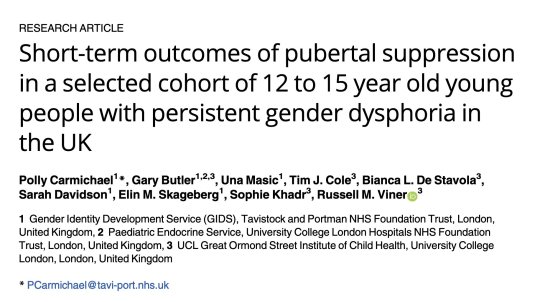



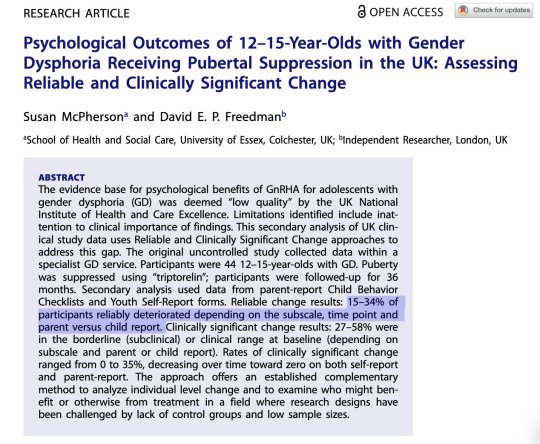




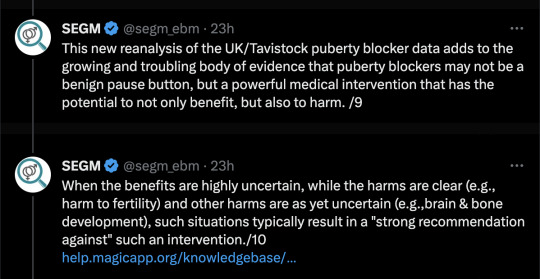


Abstract
The evidence base for psychological benefits of GnRHA for adolescents with gender dysphoria (GD) was deemed “low quality” by the UK National Institute of Health and Care Excellence. Limitations identified include inattention to clinical importance of findings. This secondary analysis of UK clinical study data uses Reliable and Clinically Significant Change approaches to address this gap. The original uncontrolled study collected data within a specialist GD service. Participants were 44 12–15-year-olds with GD. Puberty was suppressed using “triptorelin”; participants were followed-up for 36 months. Secondary analysis used data from parent-report Child Behavior Checklists and Youth Self-Report forms. Reliable change results: 15–34% of participants reliably deteriorated depending on the subscale, time point and parent versus child report. Clinically significant change results: 27–58% were in the borderline (subclinical) or clinical range at baseline (depending on subscale and parent or child report). Rates of clinically significant change ranged from 0 to 35%, decreasing over time toward zero on both self-report and parent-report. The approach offers an established complementary method to analyze individual level change and to examine who might benefit or otherwise from treatment in a field where research designs have been challenged by lack of control groups and low sample sizes.

==
Indeed.
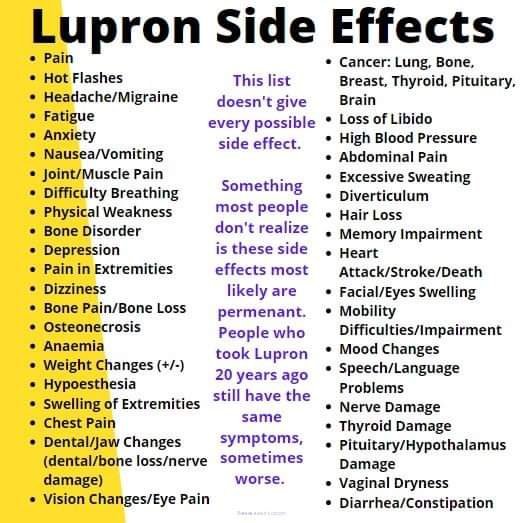
#puberty blockers#gender ideology#Ben Appel#Leor Sapir#Lupron#queer theory#medical malpractice#medical scandal#mental health#mental health issues#gender affirming care#gender affirming healthcare#affirmation model#medicalization#gender dysphoria#GnRHA#religion is a mental illness
26 notes
·
View notes
Text
I am officially a cited expert on the history of vaginal anatomy studies! Look mom! I did it!
Okay so here's the story. Way back in ye olde 2014 I was commissioned by The Sweethome (now Wirecutter) to review tampons. As part of my research for that review, I stumbled across some really fascinating old research on vaginal shapes. I wrote about that research for a group blog I used to be a part of, and about the weird little obsession I developed with some long lost research.
All I could really dig up was a set of studies done in the late 1990’s and early 2000’s by a woman named Paula Pendergrass. Pendergrass published a handful of studies about the shape of the vagina, which she measured by doing plaster casts of willing women. And what she described in her work was actually a set of different vagina shapes: the conical, the parallel sides, the heart, the pumpkin seed, and the least fortunately named slug.
But the thing that surprised me most was that after this one small set of studies by Pendergrass, that's it. There was nothing more. And it's not like Pendergrass had answered the question definitively, her work is full of ideas for how to better measure these shapes, and suggestions to collect more data. Why wasn't there anything else here? Why hadn't she continued this work? Why hadn't anybody asked more questions? I needed to know! So I managed to track her down and cold call her house in Arkansas (because journalists like me have no shame) to ask her why she stopped measuring vagina shapes.
Here's what I learned:
There’s no market for this data. Companies that manufacture vaginal products are looking only to confirm that things like tampons fit inside. They don’t care much about the specifics beyond that.
But the big reason she highlighted was the one that made me both sad and angry. When she was doing the work, people were grossed out by it. “It’s off-putting to a lot of people, and I’ve had trouble with it since I started,” she said. “People who were embarrassed I was doing this, They said I was a a dirty old woman doing this.” A dirty old woman. For wanting to know the shape and size of the human vagina.
I wanted to chase this story further, but I could never sell it. In part because it's unclear if it matters clinically what the shape of someone's vaginal canal is. And yet... it's just so... INTERESTING!
But I let it go, after that blog post. (Well, that's not entirely true, I actually ordered a dental casting kit and had plans to cast my own vaginal canal using her study's instructions. But I never got around to it.)
FLASH FORWARD TO TODAY. And I get an email from a friend named Perrin Ireland who is apparently helping someone with a book about vaginas. Did I know that my blog was cited in a scientific journal, she asked? No! I DID NOT!!!
But here it is! Gender Bias in the Study of Genital Evolution: Females Continue to Receive Less Attention than Males, Integrative and Comparative Biology, Volume 62, Issue 3, September 2022, Pages 533–541. The author, Dara Orbach, writes:
When Pendergrass et al. (1996) demonstrated that human females have differently shaped vaginas, their findings were “offputting”, Pendergrass reported being called “a dirty old woman”, and gynecologists did not recognize the value of the research (Evelith, 2016). While a national research center exists in theUnited States ofAmerica for most major organ systems (e.g., National Eye Institute), female reproductive anatomy is categorized under the umbrella of the National Institute of Child Health and Human Development. The research environment and social taboos have historically and still continue to hinder scientific inquiry in the field of female genital evolution.
Is my name spelled incorrectly? Yes! Do I care? No!
But truly it's nice to know that even though I couldn't chase this story and really report it out fully, it seems to have made some dent on at least one person who is asking questions about why we don't know more about the internal anatomy of people with vaginas.
If you like this, you'll also enjoy reading the one about how I spent weeks trying to build a replica vaginal canal in my kitchen to test menstrual cups on.
#science#science reporting#reproductive science#sexism in science#citations#my name is spelled wrong but that's fine#vaginal canal#vaginal casting#resurrected vaginal science
15 notes
·
View notes
Text



15th February 1817 saw the birth in Glasgow of Robert Angus Smith.
You may not have heard of him, or maybe you read about him in my previous post? Anyway we have all heard of acid rain, defined by National Geographic magazine thus: “Acid rain describes any form of precipitation that contains high levels of nitric and sulfuric acids. It can also occur in the form of snow, fog, and tiny bits of dry material that settle to Earth.”
The words “acid rain” were coined as long ago as 1859 by Angus Smith, who seven years earlier had made the discovery that northern cities across Britain were suffering from rainfall that contained heavy pollutants that were the result of the burning of coal that was rich in sulphur. His research found that the worst-affected city was his home town of Glasgow.
Robert Angus Smith was born in Pollokshaws the seventh son and 12th child of John Smith, originally from Ayrshire, and his wife Janet, daughter of James Thomson who owned a mill at Strathaven in Lanarkshire.
His elder brother John was a big influence on Angus’s life. John eventually became a senior teacher at Perth Academy, and was himself a scientist who would research theories on colour and light. He encouraged his younger brother to read the works of Joseph Priestley, the pioneering English chemist, and Angus Smith was greatly influenced by Priestley’s writings.
He attended Glasgow University from the age of 13, apparently to prepare for a career in the Church of Scotland ministry, but he left without graduating and then became a tutor to families, first in Scotland and then in England. In 1839 he accompanied the Bridgeman family to Germany where he remained to study under the Professor Justus Liebeg, gaining his PhD in 1841.
On returning to England he took a post at Manchester Royal Institution as assistant to Lyon Playfair, an Indian-born Scot and a scientist and politician.
Playfair passed on his own interest in the sanitation of towns and cities to Angus Smith, who left the Institution to set up in business as an analytical chemist. As concern grew about pollution, his services were in demand, and in one famous experiment he waited until a crowded room had emptied then collected the residue on windows to prove that human breath exuded not just carbon dioxide but organic matter dangerous to health.
Smith once graphically described the effects of Manchester’s polluted atmosphere, in a letter to the Manchester Guardian published on November 2, 1844.
He wrote: “Coming in from the country last week on a beautiful morning, when the air was unusually clear and fresh, I was surprised to find Manchester was enjoying the atmosphere of a dark December day… Those who would defend such evils, who would remain careless as long as any probable cause is unremoved, must surely be devoid not only of mercy, but of clear perception and of good taste. The gloominess of uncleanness is everywhere around us.”
In 1851 he began the research that would make him the “father of acid rain” as he is often known. Smith proved that sulphur compounds in the air of towns and cities were the result of burning coal and coke transported in air and rainwater, and even as the industrial revolution was bringing more and more factories into being, Smith was arguing that manufacturers should be held responsible for their pollution.
He investigated poor housing and water quality, and published numerous papers that formed the basis of the developing science of environmental chemistry. One report on the problems of pollution for the Royal Mines Commission was particularly devastating in its scientific indictment of the polluters.
Smith was called as an expert witness in a court case over factory and mine pollution and his testimony was convincing. Consequently when the British Government decided to legislate – in the Alkali Act of 1863 – to try and cut pollution from mining and manufacturing, there was really only one man to turn to as the first chief of the alkali inspectorate and thus Smith spent much of the next two decades transforming attitudes to pollution.
In 1872 Smith published his Air and Rain, the beginnings of a Chemical Climatology, in which he collected the result of his experiments. It proved how ground-breaking his work had been.
With honorary degrees from both Glasgow and Edinburgh University, Angus Smith was honoured in his own lifetime. His health declined badly in his later years and he died at at Colwyn Bay, North Wales, on May 12, 1884, being buried in the churchyard of St Paul’s, Kersal, Manchester.
He was paid a most generous tribute in the first edition of Nature magazine following his death: “For upwards of 40 years he laboured unceasingly to show how chemistry might minister to the material comfort and physical well-being of men — not in the manufacture of new compounds useful in the arts, or in the establishment of new industries – but in raising the general standard of the health of communities by checking or counteracting the evils which have followed in the train of that enormous development of the manufacturing arts which is the boast of this century.
“In his true vocation, as the chemist of sanitary science, Smith worked alone, and we have yet to find the man on whom his mantle has fallen."
12 notes
·
View notes
Text
In 1986, UCLA researcher Neil Malamuth reported that 30 percent of college men said they would commit rape if they could be sure of getting away with it. When the survey changed the word “rape” into the phrase “force a woman into having sex,” 58 percent said that they would do so. Ms. magazine commissioned a study funded by the National Institute for Mental Health of 6,100 undergraduates, male and female, on thirty-two college campuses across the United States. In the year prior to the Ms. survey, 2,971 college men had committed 187 rapes, 157 attempted rapes, 327 acts of sexual coercion, and 854 attempts at unwanted sexual contact. The Ms. study concluded that “scenes in movies and TV that reflect violence and force in sexual relationships relate directly to acquaintance rape.”
In another survey of 114 undergraduate men, these replies emerged:
“I like to dominate a woman.” 91.3%.
“I enjoy the conquest part of sex.” 86.1%.
“Some women look like they’re just asking to be raped.” 83.5.%
“I get excited when a woman struggles over sex.” 63.5%.
“It would be exciting to use force to subdue a woman.” 61.7%.
- The Beauty Myth by Naomi Wolf.
49 notes
·
View notes
Text
The number of women dying from alcohol-related diseases has soared in recent years, new figures show, with experts blaming the rise on brands deliberately targeting marketing at women.
The latest data reveals the number of women who lost their lives this way in the UK increased by 37 per cent in five years – surging from 2,399 to 3,293 between 2016 and 2021 and marking the highest levels since records began.
While more men than women still die from alcohol-related diseases, the Office for National Statistics figures show deaths are rising substantially quicker for women than for men, with the latter seeing a 28 per cent in the same period – from 4,928 to 6,348.
Professor Debbie Shawcross, a professor of hepatology and chronic liver failure at King’s College London’s Institute of Liver Studies, said liver disease was a particular problem in female patients.
“Women tend to present with more severe liver disease, particularly alcohol-related hepatitis, and do so after a shorter period of excessive drinking and at a lower daily alcohol intake than men,” she said. “This can be accounted for by differences in body size and composition – less muscle mass.”
Richard Piper, chief executive of the charity Alcohol Change, claimed the main factor causing the surge is the “incessant marketing of drinks towards women” as he called for stricter regulation of alcohol advertising.
Abigail Wilson, from WithYou, a drug, alcohol and mental health charity, described the rise in women dying from alcohol-related liver disease as “very concerning” as she argued alcohol was as damaging as heroin and crack cocaine. “Women generally are less likely to die of alcohol-related causes than men. There is always a gap there but the gap is closing, and that is really concerning.”
The Independent can also report that:
The number of deaths among women attributed to alcohol-related liver disease in England increased from 1,533 to 2,190 deaths between 2015 and 2021 – a 42 per cent rise
The total number of male deaths linked to alcohol-related liver disease climbed by 34 per cent to 3,870 deaths in the same timeframe
Recent research from 33 countries found that British women are the biggest female binge drinkers
Exclusive polling from WithYou shows almost two-thirds of those who seek support online are women, with more than half seeking support for their alcohol use
Roxanne Knighton, who lives in Staffordshire, told The Independent of the pain of losing her mother Melanie to alcohol-related liver disease in March 2022. She was diagnosed with the illness in her late forties.
“All the earliest memories were mum drinking,” the 34-year-old recalled. “She was alcohol dependent – it made her function.”
Ms Knighton said her mother never went to the doctor and was in denial about her drinking. So Ms Knighton made the call instead.
“It was me who called the doctors as she couldn’t get up off the sofa – she was full of fluid,” she added. “It had gone into her belly, she had to be drained, they got 12 litres from her.
“I was looking after her each day. It was four years until she died. It still hurts. I didn’t just lose her, I lost her to the alcohol first. You lose them twice.”
Raising concerns about the “feminisation” of alcohol marketing, Dr Piper highlighted annual reports of major alcohol brands which reveal they are deliberately targeting women.
“This is leading to deaths,” he said. “The second reason would be pricing – alcohol is more affordable now than it has been at any point in the last 20 years so people are drinking more.”
He called for ministers to introduce tighter rules on alcohol marketing and roll out minimum unit pricing for alcohol to make drinks with higher alcohol content more expensive.
Other campaigners warned it is harder for women to get support for alcohol misuse due to services often being tailored towards men. Women routinely do the lion’s share of childcare, meaning they cannot physically find the time, they say.
Helena Conibear, chief executive of the Alcohol Education Trust, attributed the rise in women dying from alcohol-related liver disease to a significant increase in binge drinking in the late Nineties and early 2000s.
Meanwhile, Prof Shawcross argued women who struggle with alcoholism endure greater “cultural stigma” than their male counterparts, which may deter women from pursuing help.
Alcohol-related liver disease often has no symptoms for many years, she added, while women also have lower levels of the enzyme which breaks down alcohol.
Vanessa Hebditch, of the British Liver Trust, said: “With alcohol becoming increasingly accessible and affordable, as well as more ingrained in our culture, more women are drinking to levels that put their health at risk.”
Siobhan Herbert, a project manager, told The Independent she started drinking a bottle of wine a night – and sometimes two bottles on weekend evenings – around 20 years ago.
“When I went out, I drank less,” the 52-year-old added. “I was a bit of a closet drinker. At home, there would be nobody around to witness me getting trollied. My mother was an alcoholic, she was exactly the same. You would have thought growing up, seeing all that through my teenage years, it would stop you, but it is very addictive.”
Ms Herbert said she eventually stopped drinking in June 2022 due to growing fed up with the impact alcohol was having on her physical and mental health.
She added: “I wasn’t putting Baileys on my cornflakes but every day I felt awful. I felt tired and anxious.
“I am a whole new woman now. I feel alive. I have more energy. I am sharper. I do not have anxiety. My depression is gone and all of the problems I was blaming on the menopause have massively improved.”
Sandra Parker, a self-professed “classic binge drinker”, said she would struggle to know how much alcohol she had consumed due to blacking out and would sometimes be in bed for two days afterwards.
The 54-year-old, who stopped drinking in 2018, now coaches women to help them stop or cut down on their alcohol consumption, describing her clients as successful professional middle-class women who are secretly drinking harmful amounts of wine at home.
“They may have a single drink when they are out with people from work, or they may not even drink, but they come home and they have a bottle of wine,” she added. “They have learnt that when they have a drink, they feel less stressed, and it becomes a dependency where they really crave that feeling each night.”
A Department of Health spokesperson said. “Alcohol misuse can ruin lives and destroy families, which is why we are acting to support those most at risk.
“We’ve published a 10-year plan for tackling drug and alcohol-related harms and are investing an extra £532m between 2022 and 2025 to create places for 50,000 people in drug and alcohol treatment services. We are also funding specialist alcohol care teams at one in four hospitals in England, based on those with the greatest need.
“Our 10-year women’s health strategy sets out our plan for improving care and support for women.”
13 notes
·
View notes
Text

“The NHS is shutting down its gender identity clinic for children after a damning review found that it failed vulnerable under-18s.
The gender identity service at Tavistock & Portman NHS Foundation Trust has been ordered to close by spring 2023.
It will be replaced by regional centres at existing children’s hospitals offering more “holistic care” with “strong links to mental health services”.
Tavistock’s Gender Identity Development Service (GIDS) clinic has been accused of rushing children into life-altering treatment on puberty blockers.
The paediatrician Dr Hilary Cass, who is leading a review of the service, has today issued a series of recommendations for a radical overhaul of how the NHS treats young people who are questioning their gender identity.
She found that the Tavistock clinic was “not a safe or viable long-term option” and that other mental health issues were “overshadowed” when gender was raised by children referred to the clinic.
Cass, former president of the Royal College of Paediatrics and Child Health, said the current model of a sole provider for gender services should be scrapped as it failed to meet the holistic needs of distressed and vulnerable teenagers.
She said Tavistock should be replaced by regional centres with an “appropriate multi-professional workforce to enable them to provide an integrated model of care that manages the holistic needs of this population”.
Amid concerns that the clinic fails to take into account wider health problems before putting children on puberty blockers, Cass added: “Staff should maintain a broad clinical perspective in order to embed the care of children and young people with gender uncertainty within a broader child and adolescent health context.”
NHS England, which commissioned Cass to review the service in September 2020, say they will implement her recommendations in full and decommission the Tavistock clinic.
They have announced they will launch two new clinics for children with gender dysphoria by spring 2023, which will bring together multiple doctors from a broad range of specialities.
The first, in London, will be based at Great Ormond Street Hospital and receive specialist mental health support from the South London and Maudsley NHS Foundation Trust.
The second, in the northwest, will be led by a partnership between Alder Hey Children’s NHS Foundation Trust and the Royal Manchester Children’s Hospital.
Cass said these clinics must have “established academic and education functions” to monitor evidence on children who are put on hormone therapy. The Tavistock clinic failed to collect sufficient data on the impact of puberty blockers in under-16s.
She said there was currently “insufficient evidence” for her to make any firm recommendations around their routine use.
Cass told the NHS to “enrol young people being considered for hormone treatment into a formal research protocol with adequate follow up into adulthood, with a more immediate focus on the questions regarding puberty blockers”.
The NHS said it would launch clinical trials in partnership with the National Institute for Health and Care Research to follow children on puberty blockers into adulthood.
A spokesman said: “This will ensure that there is greater transparency for children and their parents/carers around the uncertain clinical benefits and longer-term health impacts surrounding their use.”
The clinic has been overwhelmed by a sudden increase in referrals, particularly among young girls and children on the autism spectrum. Last year it received more than 5,000 referrals, compared to 250 a decade ago.
Cass’s final report will be published next year. Her interim review published in March found that services had developed without clear rules and that there was a “clinician lottery”, with widely varying approaches to treatment.
She found there was “a lack of agreement, and in many instances a lack of open discussion” about whether unhappiness with gender in adolescence was permanent or temporary. However, last year the Court of Appeal overturned a controversial ruling made by the High Court that children under 16 were unlikely to be able to give informed consent to receiving puberty blockers.
The case was brought against the Tavistock and Portman trust by Keira Bell, 24, who began taking puberty blockers when she was 16 to transition to male before later “detransitioning”.”
Link | Archived Link
249 notes
·
View notes
Text
"Published in The Lancet Psychiatry, the new study from the University of Oxford and the National Institute for Health and Care Research (NIHR) Oxford Health Biomedical Research Centre investigated neurological and psychiatric diagnoses in over 1.25 million people following diagnosed COVID-19 infection, using data from the US-based TriNetX electronic health record network.
The study reports on 14 neurological and psychiatric diagnoses over a 2-year period and compares their frequency with a matched group of people recovering from other respiratory infections. It also reports data in children and older adults separately, and compares data across three waves of the pandemic. To our knowledge, these are the first robust data addressing these important questions."
#mask up#covid#covid 19#covid isn't over#pandemic#covid conscious#long covid#covid is airborne#wear a mask#coronavirus
10 notes
·
View notes
Text
"We are killing this ecosystem": the scientists tracking the Amazon's fading health
Climate change, deforestation and other human threats are driving the Amazon towards the limits of survival. Researchers are racing to chart its future.

Luciana Gatti stares grimly out of the window of the small aircraft as it takes off from the city of Santarém, Brazil, in the heart of the eastern Amazon forest. Minutes into the flight, the plane passes over a 30-kilometre stretch of near-total ecological devastation. It’s a patchwork of farmland, filled with emerald-green corn stalks and newly clear-cut plots where the rainforest once stood.
“This is awful. So sad,” says Gatti, a climate scientist at the National Institute for Space Research in São José dos Campos, Brazil.
Gatti is part of a broad group of scientists attempting to forecast the future of the Amazon rainforest. The land ecosystems of the world together absorb about 30% of the carbon dioxide released by burning fossil fuels; scientists think that most of this takes place in forests, and the Amazon is by far the world’s largest contiguous forest.
Since 2010, Gatti has collected air samples over the Amazon in planes such as this one, to monitor how much CO2 the forest absorbs. In 2021, she reported data from 590 flights that showed that the Amazon forest’s uptake — its carbon sink — is weak over most of its area1. In the southeastern Amazon, the forest has become a source of CO2.
The finding gained headlines around the world and surprised many scientists, who expected the Amazon to be a much stronger carbon sink. For Carlos Nobre, a climate scientist at the University of São Paulo Institute of Advanced Studies in Brazil, the change was happening much too soon. In 2016, using climate models, he and his colleagues predicted that the combination of unchecked deforestation and global climate change would eventually push the Amazon forest past a “tipping point”, transforming the climate across a vast swathe of the Amazon2. Then, the conditions that support a lush, closed-canopy forest would no longer exist. Gatti’s observations seem to show the early signs of what he forecast, Nobre says.
“What we were predicting to happen perhaps in two or three decades is already taking place,” says Nobre, who was one of a dozen co-authors of the paper with Gatti.
Continue reading.
#brazil#politics#brazilian politics#environmentalism#science#amazon rainforest#mod nise da silveira#image description in alt
22 notes
·
View notes
Text
For too long, California and other states have viewed stormwater as either a threat or an inconvenience — something to be whisked away from cities and communities as quickly as possible.
But as traditional sources of water face worsening strain from climate change, population growth, agriculture and other factors, those unused gallons of rainwater pouring across asphalt or down rain gutters are starting to be viewed as an untapped resource that can help close the widening gap between supply and demand.
In a report released Thursday, researchers with the Pacific Institute determined that every year, 59.5 million acre-feet of stormwater go uncaptured across the United States — or roughly 53 billion gallons per day. The amount is equivalent to 93% of the water withdrawals for municipal and industrial uses in 2015, the most recent year for which national data were available.
"The numbers are clear. It's time to elevate the role of stormwater capture in the national water conversation," said Bruk Berhanu, the report's lead author and a senior researcher with the Pacific Institute, a California-based water-focused think-tank.
Of the 10 states with the most "untapped potential," California ranks ninth with approximately 2.27 million acre-feet of urban area runoff each year. (An acre-foot is about 326,000 gallons — enough water to supply up to three homes for a year).
What's more, Los Angeles represents the urban area with the greatest stormwater runoff potential in the West, ranking 19th in the country. The census-defined urban area includes L.A., Long Beach and Anaheim, and experiences approximately 490,000 acre-feet of runoff each year, or roughly 437 million gallons per day.
It would not be feasible or desirable to capture every drop of that missed water, as some stormwater is needed for environmental use, ecological health, recreation and other purposes, Berhanu said. Yet the sheer volume indicates that far more could be done, and that stormwater could become a significant supply alternative in communities across the country.
Texas was the state with the most untapped potential, 7.8 million acre-feet of urban area runoff each year. The analysis accounted for the size of each urban area as well as its historic annual rainfall, the researchers said.
The findings come at a critical moment. In California and many other parts of the world, traditional water sources — including underground aquifers and fresh water from rivers, streams and snowmelt — are becoming less reliable.
The Fifth National Climate Change Assessment found that the American Southwest can expect extended periods of reduced precipitation in the years ahead, which will be interrupted by bursts of extreme rainfall and flooding. The Colorado River — a water lifeline for 40 million people across the region — is projected to see flows reduced by as much as 30% by 2050.
In response to tightening supplies, urban water managers are turning to strict conservation measures and alternatives such as desalination and recycled wastewater to help keep taps flowing. But stormwater is also an asset, and a growing number of cities and states are beginning to implement projects to take advantage of rainfall when it comes.
For years, stormwater "was seen as a problem, as a burden you've got to push somewhere else, whereas today, we're looking at it more as a resource," said Seth Brown, executive director of the nonprofit National Municipal Stormwater Alliance. "That's the big paradigm shift that's been going on in the stormwater sector."
Despite this growing interest, the report found that greater uptake of stormwater is hindered by a lack of comprehensive data characterizing the national volumetric potential, as well as the lack of a nationwide framework for stormwater capture, treatment and reuse, among other barriers.
Water rights and public health codes governing use and pollutants are also challenges, Brown said. Funding can also be a hurdle because stormwater efforts often require long-term thinking and investments.
But the payoff is worth it — particularly as the limitations of past unsustainable practices become clearer, he said. While stormwater likely would not replace all other supplies, it could be a key piece of a city's or region's water portfolio.
"What we're going to see in the future is going to be an all-of-the-above kind of thing — it's going to be water recycling as well as stormwater capture and reuse," Brown said. "It's going to play a significant enough role where we should talk about it, and think about it, and start addressing it now."
In California, officials are working to achieve this through a number of projects. During the 2023 water year, state agencies permitted more than 1.2 million acre-feet of groundwater recharge — including nearly 400,000 acre-feet that were recharged after Gov. Gavin Newsom temporarily lifted regulations to allow more floodwater from storms to be diverted into areas where it could percolate into the ground.
The state is also moving forward with plans for a proposed tunnel that would capture and move more water from the Sacramento-San Joaquin River Delta during wet years. Had the tunnel been operational this winter, the Department of Water Resources could have captured about 481,000 acre-feet of stormwater between Jan. 1 and Feb. 22, or enough water for about 5 million people for a year, officials said.
"The recent winter storms have brought a lot of water that has the potential to be captured and stored underground to replenish groundwater basins," said Margaret Mohr, the DWR's deputy director of communications. She noted that since 2019, the state has invested more than $160 million in projects that help urban areas capture, store and reuse runoff.
"As we face a hotter, drier future brought on by climate change, we are going to continue to see less snowpack, meaning we can't rely as heavily on snowpack for future water supply as we have in the past," Mohr said. "California must continue to invest in water management strategies like stormwater capture, groundwater recharge and recycled water to ensure that our water supply remains safe and reliable and to provide continued flood protection for communities."
Los Angeles too is taking steps to improve its stormwater capture capabilities. In 2018, Angelenos passed Measure W, a tax aimed at capturing and cleaning more stormwater before it reaches the ocean. The program, which allocates about $280 million annually to stormwater projects, has seen some success, although a recent assessment found its progress has been slow.
The work often includes removing concrete, asphalt and other aspects of the built environment to create more opportunities for stormwater to seep into the ground, where it can recharge the aquifers that feed the city's supplies.
The program's ultimate goal is to capture 300,000 acre-feet of water per year by 2045. On average, L.A. County now captures and infiltrates about half that, according to Vision 45, a report released by the Natural Resources Defense Council, Heal the Bay and Los Angeles Waterkeeper last year.
That report provides a road map for a more sustainable water future in L.A. and includes several recommendations to improve stormwater capture. Among them are newly constructed regional projects; better use of existing projects; and the implementation of projects at the parcel and neighborhood scale.
"[E]ach year, whether we have above- or below-average rainfall, billions of gallons of stormwater flow over paved surfaces, through the storm drain system, and out to the ocean without the opportunity for infiltration because we do not yet have the infrastructure to capture all the rain that falls in a single rain event," it said.
The Pacific Institute's assessment also outlines a number of recommendations to improve stormwater capture, beginning with more detailed quantification of opportunities at local, regional and state levels, as well as the creation of national guidelines.
Other recommendations include expanded funding and financing opportunities for stormwater capture; enhanced regional approaches and collaboration between agencies; and reduced restrictions on how stormwater can be used. Public-private partnerships can also make a big difference since "runoff is generated on privately owned land just as much as publicly owned land," said Berhanu, the lead author.
That could mean rain barrels or rain gardens on front lawns, or increased interest from corporations with large real estate portfolios. San Francisco, for example, now requires large new developments of 100,000 square feet or more to install onsite reuse systems, such as graywater or stormwater systems, for irrigation, toilets and other nonpotable uses.
"We definitely don't want to point to one particular strategy over another, but it is very clear that there needs to be a mix of strategies involved," Berhanu said.
Heather Cooley, director of research with the Pacific Institute, noted that stormwater capture has other benefits as well.
"Urban runoff into waterways is a major source of pollution," she said. "Metals, nutrients, chemicals, pesticides — all sorts of things we're using in our urban spaces and discharging those into waterways. So it not only helps to avoid downstream water supply impacts, but it can provide water quality benefits as well."
Stormwater capture is also a key component of flood control, as channels such as the Los Angeles River help to prevent water from flowing into neighborhoods during heavy storms.
But all of those needs and uses could be better addressed through improved stormwater capture capabilities and making sure more drops are saved, the report says.
"This research shows it's a lot of water," Cooley said. "It could be a significant component of our water supply, and could help to fill that supply-demand gap in communities across the U.S."
7 notes
·
View notes